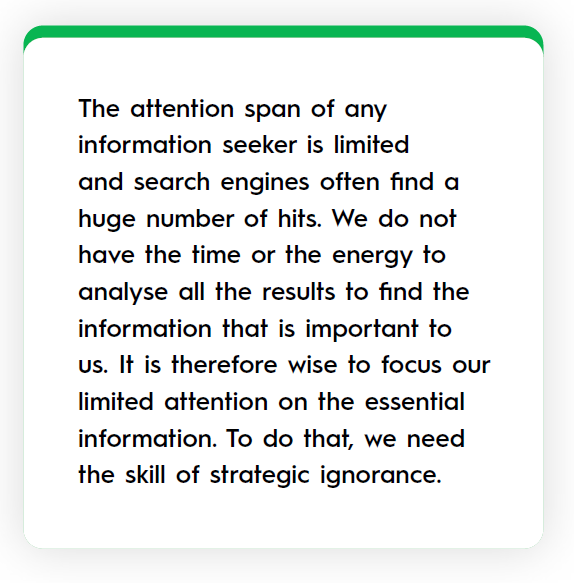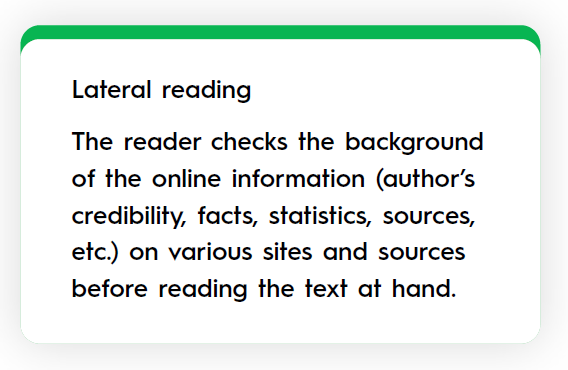
Online vs. offline environments
According to Koryzeva et al (2020) in an excellent article “Citizens versus the internet”(2), online environments are replete with smart, highly adaptive choice architectures, designed primarily to maximise commercial interests, capture and sustain the users’ attention, monetise user data, and predict & influence future behaviour. In the worst case scenario this can facilitate the spread of disinformation.
Online and offline environments differ from each other in ways that have important consequences for people’s online experiences and behaviour. In the online environment, one can broadcast a message to an audience of millions, whereas in face-to-face communication, there are physical limits to how many people can join a conversation (3).

The amount of information available to anybody in digital environments is breathtaking and it is possible to diffuse any information effortlessly to vast audiences in no time. Online environments develop rapidly and constantly compared with most offline environments. Contents can be changed, removed and added all the time.
Kozyreva et al. identified four types of challenges typical to online environments: persuasive and manipulative choice architectures, AI-assisted information architectures, false and misleading information, and distracting environments. When people are accessing online information through search engines, their results are regulated by algorithms developed by corporations “in pursuit of profits and with little transparency or public oversight” In addition, “in democratic countries technology companies have accumulated unprecedented resources, market advantages, and control over people’s data and access to information” (4). The collection of data from online users is based on highly developed machine-learning systems and algorithms which outperform us humans and which are not transparent. That’s why the results of the search engines and recommender system used for instance by Youtube are individualised and unpredictable.
One solution to this challenge is education. According to researchers, interventions directed to the public as recipients and producers of information, namely in the school curricula for digital-information literacy, would teach students how to search, filter, evaluate, and manage data, information, and digital content (5). For all these reasons, traditional reading skills should be complemented by new types of online evaluation strategies and online reading skills.
Faktabaari EDU (6) has been promoting information literacy for Finnish teachers and students in line with the Finnish core curricula goals and objectives (informaatiolukutaito-opas) (7).Because the online scene is developing so fast, we are obliged to update the information literacy guide book published in 2020 with this digital information literacy guidebook. We have added new tools to the digital information literacy toolbox.

Online reading toolbox
It should be noted that good digital literacy skills alone are not enough. Good subject-matter knowledge can make us better at assessing the credibility of information (8). If you have a good understanding of a certain topic, it is harder for you to be misled (9). With the understanding of climate change providing a good test case which shows that if one has good knowledge about a certain topic, then it is harder to get misled. However, general higher education may not make you much better at navigating disinformation (10).
The ability to find credible information online is necessary for informed civic engagement – it is a new citizenship skill. This need is particularly acute for young people, who often turn to the internet to learn about social and political issues. Preparing students to evaluate online content, particularly as it concerns social and political issues, aligns with broader efforts to reinvigorate the civic mission of colleges and universities. According to a recent study (11), the majority of students employed ineffective strategies for evaluating digital information.
Therefore, it is extremely timely and important to promote online reading skills and online evaluation strategies.
Pre-bunking
Pre-bunking is the name for a process where people are warned in advance that they are about to be the target of false information. Pre-bunking skills can be promoted by providing people with factual and some in-depth information on a particular subject beforehand, and then introducing the existing disinformation about the same subject. They can also be told in advance what kinds of disinformation they can expect.
A good pre-bunk addresses people’s concerns, speaks to their lived experience and compels them to share that knowledge. Prebunks are empowering: The whole point is about building trust with your audience instead of simply correcting facts.
Research has shown that the logic-based approach has far-reaching benefits. If you teach people to recognize tactics, they can spot them more often than individual claims (12).

Debunking
Debunking takes place after the false information has appeared. The aim is to correct false information and to prevent others from believing what is verifiably false information. Fact checking strategies can be used to debunk misinformation and disinformation.
Correcting or “disproving” false information is challenging because people are more likely to believe familiar information even if they later learn that the information is incorrect (the familiarity backfire effect).
Research shows that when correcting misinformation, it is best to present key facts before presenting the misinformation to be corrected. It is not enough to correct the misinformation. It is necessary to explain why the information is wrong and to provide a truthful counterpart or explanation. The Debunking Handbook (13) identifies four key areas of myth debunking:
- Key facts: emphasise what is true rather than what is false. Research shows that when debunking misinformation, it is best to present the core fact first before presenting the misinformation that needs to be debunked.
- Clear warnings.
- Alternative explanation: ‘When you refute a myth, you create a hole in the human mind. To be effective, your refutation must fill this gap”. If you want to replace incorrect information, provide a clear explanation that fills the “information gap”. Try to explain things as clearly as possible: people may stop paying attention if they are confronted with overlapping information. This can sometimes mean leaving out some nuances when people are first presented with corrected information.
- Graphics: visual presentations can help to illustrate key facts more clearly.
Sourcing
Sourcing in text comprehension has been found to have a significant effect on students’ abilities to determine credibility and evaluate information, effect sizes ranging from small to large (14). Knowing where good information is, source trustworthiness, may be as important as source criticism in order to be a well-informed citizen (15). Therefore, it is important to share where reliable information can be found and who can be trusted.
Civic online reasoning
Teaching civic online reasoning (16) has proved to be a more challenging task. Researchers at Stanford (17)(18) propose that when one comes across online information, one should ask oneself three key questions:
- Who’s behind the information?
- What’s the evidence? and
- What do other sources say?
Research on curricular activity to promote civic online reasoning have been effective in advancing individuals in digital source criticism and lateral reading (19).
Teaching young people how to use cognitive strategies and digital tools to verify information, has also been shown to have medium size effects on their ability to distinguish between credible and misleading information (20). Especially those teenagers who, after the self-test or teaching, used digital tools, such as text searches or reverse image search, managed to debunk misleading news.

Strategic ignorance
When using powerful search engines, we sometimes get millions of hits. How to select information which is useful, truthful and which meets our initial information need? In this process we need human critical thinking to evaluate the value of the content algorithms are proposing for us – and we have put aside and ignore, most of the hits.
Already in 1971 – far before the time of the Internet – Herbert Simon (21) noted that information overload results in a scarcity of attention (22). Advertisers, corporations, lobbyists, clickbait sites, conspiracy theorists, hate groups, and propaganda-fuelling governments work overtime to hijack our online attention. Often the wisest thing to do is to preserve attention by practising strategic ignoring. Under conditions of limited attention, the most crucial decision to make is where to allocate it.
So, we must develop skills to ignore great amounts of non-important information. We should embrace strategic ignoring to avoid disinformation and to preserve our limited amount of attention on content which is really worth reading.
Lateral reading

One of the new tools in the digital information literacy toolbox is the lateral reading approach in which the reader verifies the background of the online information (reliability of the source, facts, stats, sources) from different sites and sources before starting to read the text at hand.
Due to the differences between the online and offline information environments, it is necessary to pay more attention to the source of the online information. The traditional reading approach can be ineffective in a digital environment. If we are too busy to analyse unfamiliar online information without checking the origin of the article in the first place – we might not necessarily notice that the whole text is based on biased information.
Wineburg & McGrew (2019) (23) observed how students, academics and fact-checkers deal with previously unknown online information. Fact-checkers opened up several tabs across the horizontal axis of their browser and searched for information about the organisation or individual behind it. Only after verifying what other sites had to say, they returned to the text. Using this approach, fact checkers were able to quickly verify sites that masked their intent and sponsors. In the same experiment students and academics were focused on the original site, resulting in confusion about its real agenda or sponsor.
The strategy used by professional fact-checkers to read online feeds laterally across many connected sites instead of digging deep into the text at hand has proven to be a quick and effective way to avoid spending attention, time and energy on biased information. The use of the click restraint strategy is recommended. It means that one should carefully scroll down before clicking links in search results that are relevant and not necessarily ranked as the top result and take bearing towards reliable sources of information (24). Reading of multiple, relevant sources in order to be able to corroborate and contextualise the information enables us to make well-informed judgments about the trustworthiness of the source.
Online traffic rules
In July 2022, the European Parliament adopted the Digital Services Act (DSA) (25) and Digital Markets Act (DMA) (26). These new EU digital rulebooks set out unprecedented standards on the accountability of online companies, within an open and competitive digital market. Once the new rules are implemented in practice, users in the EU will have more choices and their rights will be better protected online.
It would be beneficial if the big online platforms would start to regulate their content more carefully in the future as foreseen by these Acts. But unfortunately, we cannot count on the good will of the platforms. We need to improve our digital skills and educational input! Citizens should be taught to develop their critical thinking and digital information literacy skills.
Simple online traffic rules would be useful for us all. When I was at school, I was taught simple traffic instructions: First, look to left – and then to right – and to left again before crossing the street. We need similar clear instructions also for online environments.

References:
(1) Hobbs, R. (2010). Digital and media literacy: A plan of action. The Aspen Institute. https://assets.aspeninstitute.org/content/uploads/2010/11/Digital_and_Media_Literacy.pdfMihailidis, P., & Thevenin, B. (2013). Media literacy as a core competency for engaged citizenship in participatory democracy. American Behavioral Scientist, 57(11), 1611–1622. https://doi.org/10.1177/0002764213489015
(2) Kozyreva, A., Lewandowsky, S. and Hertwig, R. (2020). Citizens Versus the Internet: Confronting Digital Challenges With Cognitive Tools. Association for Psychological Science. SAGE
(3) Barasch, A., & Berger, J. (2014). Broadcasting and narrowcasting: How audience size affects what people share. Journal of Marketing Research, 51, 286–299. https://doi.org/10.1509/jmr.13.0238
(4) Zuboff, S. (2019). The age of surveillance capitalism: The fight for the future at the new frontier of power. Profile Book
(5) Breakstone, J., McGrew, S., Smith, M., Ortega, T., & Wineburg, S. (2018). Teaching students to navigate the online landscape. Social Education, 82, 219–221.
(6) Faktabaari EDU https://faktabaari.fi/
(7) Kivinen, K. (Ed. 2020) Informaatiolukutaito-opas. Faktabaari. https://faktabaari.fi/assets/Informaatiolukutaito-opas_Faktabaari_EDU.pdf
(8) Lurie, E., & Mustafaraj, E. (2018, May). Investigating the Effects of Google’s Search Engine Result Page in Evaluating the Credibility of Online News Sources. In Proceedings of the 10th ACM Conference on Web Science (pp. 107-116)
(9) Nygren, T., & Guath, M. (2021a). Students evaluating and corroborating digital news. Scandinavian Journal of Educational Research, in press.
(10) Roozenbeek, J., van der Linden, S., & Nygren, T. (2020). Prebunking interventions based on “inoculation” theory can reduce susceptibility to misinformation across cultures. Harvard Kennedy School Misinformation Review, 1(2).
(11) Joel Breakstone, Mark Smith, Nadav Ziv & Sam Wineburg (2022) Civic Preparation for the Digital Age: How College Students Evaluate Online Sources about Social and Political Issues, The Journal of Higher Education, DOI: 10.1080/00221546.2022.2082783
(12) First Draft https://firstdraftnews.org/articles/a-guide-to-prebunking-a-promising-way-to-inoculate-against-misinformation/
(13) Debunking Handbook (2020) https://www.climatechangecommunication.org/wp-content/uploads/2020/10/DebunkingHandbook2020.pdf
(14) Brante, E. W., & Strømsø, H. I. (2018). Sourcing in Text Comprehension: a Review of Interventions Targeting Sourcing Skills. Educational Psychology Review, 30(3), 773-799. doi:10.1007/s10648-017-9421-7
(15) Haider, J., & Sundin, O. (2020). Information literacy challenges in digital culture: conflicting engagements of trust and doubt. Information, Communication & Society, 1-16. doi:10.1080/1369118X.2020.1851389
(16) Civic Online Reasoning site of Stanford University https://cor.stanford.edu/
(17) Breakstone, J., Smith, M., Wineburg, S., Rapaport, A., Carle, J., Garland, M., & Saavedra, A. (2021). Students’ Civic Online Reasoning: A National Portrait. Educational researcher, 50(8), 505-515. doi:10.3102/0013189X211017495
(18) Wineburg, S, Breakstone, J., McGrew, S., Smith, M., and Ortega, T. (2022) Lateral Reading on the Open Internet: A District-Wide Field Study in High School Government Classes Journal of Educational Psychology (Accepted for publication)
(19) McGrew, S., & Byrne, V. L. (2020). Who Is behind this? Preparing high school students to evaluate online content. Journal of Research on Technology in Education, 1-19. doi:10.1080/15391523.2020.1795956
(20) Axelsson, C.-A. W., Guath, M., & Nygren, T. (2021). Learning How to Separate Fake From Real News: Scalable Digital Tutorials Promoting Students’ Civic Online Reasoning. Future Internet, 13(3 60), 1-18.
(21) Simon, H. A. (1971). Designing organizations for an information-rich world. In M. Greenberger (Ed.), Computers, communications, and the public interest (pp. 37–72). John Hopkins University Press
(22) Wineburg, S., & McGrew, S. (2019). Lateral reading and the nature of expertise: Reading less and learning more when evaluating digital information. Teachers College Record, 121(11), Article 22806. https://www.tcrecord.org/content.asp?contentid=22806
(23) Wineburg, S., & McGrew, S. (2019). Lateral reading and the nature of expertise: Reading less and learning more when evaluating digital information. Teachers College Record, 121(11), Article 22806. https://www.tcrecord.org/content.asp?contentid=22806
(24) Breakstone, J., Smith, M., Wineburg, S., Rapaport, A., Carle, J., Garland, M., & Saavedra, A. (2021). Students’ Civic Online Reasoning: A National Portrait. Educational researcher, 50(8), 505-515. doi:10.3102/0013189X211017495
Kari Kivinen, PhD, is an Education outreach expert at EUIPO. He has over 30 years of experience in international education. Since 2017 he has led the pedagogical development work at Faktabaari EDU digital information literacy service building on fact-checking methodology and co-authored and piloted the learning materials with fellow teachers around Finland and abroad. He is a member of the Commission expert group on tackling disinformation and promoting digital education. The author works for EUIPO and agency of the EU but the views expressed are purely personal and cannot be taken as being official statements of either the EU or the EUIPO.
Artwork: Lumi Pönkä
Download the Digital Information Literacy Guide (PDF).

